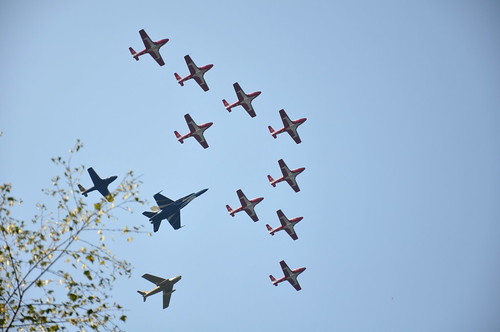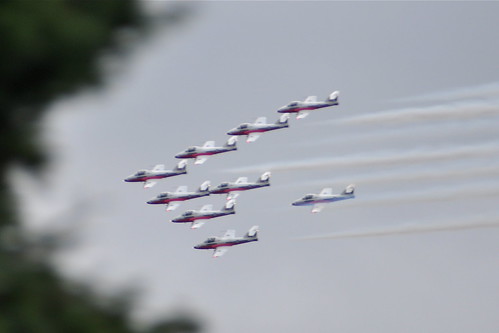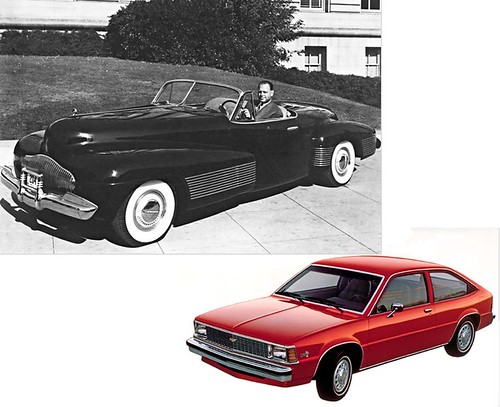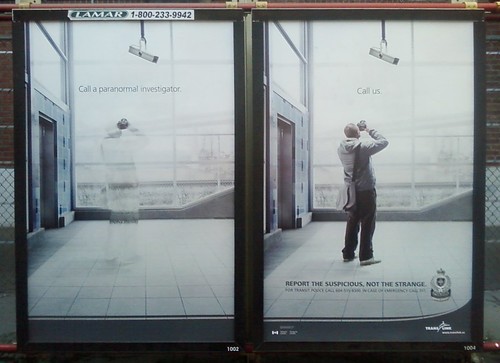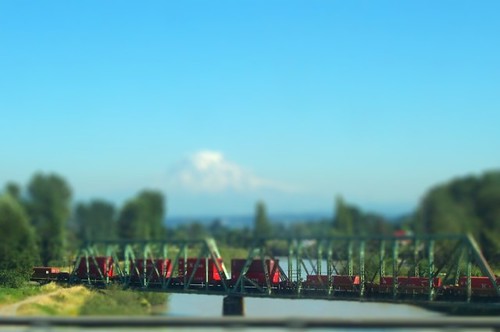Penmachine
26 April 2010
Two more arguments for learning statistics
One of my repeated themes here over the years is how genuinely lousy the human brain is at intuitively understanding probability and statistics. Two articles this week had me thinking about it again.
The first was Clive Thompson's latest opinion piece in Wired, "Why We Should Learn the Language of Data," where he argues for significantly more education about stats and probability in school, and in general, because:
If you don't understand statistics, you don't know what's going on—and you can't tell when you're being lied to.
Climate change? The changing state of the economy? Vaccination? Political polls? Gambling? Disease? Making decisions about any of them requires some understanding of how likelihoods and big groups of numbers interact in the world. "Statistics," Thompson writes, "is the new grammar."
The second article explains a key example. At the NPR Planet Money blog (incidentally, the Planet Money podcast is endlessly fascinating, the only one clever enough to get me interested in listening to business stories several times a week), Jacob Goldstein describes why people place bad bets on horse races.
After exhaustive statistical analyses (alas, this stuff isn't easy), economists Erik Snowberg and Justin Wolfers have figured out that even regular bettors at the track simply misperceive how bad their bets are, especially when wagering on long shots—those outcomes that are particularly unlikely, but pay off big if you win, because:
...people overestimate the probability of very rare events. "We're dreadful at perceiving the difference between a tiny probability and a small probability."
In our heads, extremely unlikely things (being in a commercial jet crash, for instance) seem just as probable, or even more probable, than simply somewhat unlikely things (being in a car crash on the way to the airport). That has us make funny decisions. For instance, on occasion couples (parents of young children, perhaps) choose to fly on separate planes so that, in the rare event that a plane crashes, one of them survives. But they both take the same car to the airport—as well as during much of the rest of their lives—which is far, far more likely to kill them both. (Though still not all that likely.)
Unfortunately, so much of probability is counterintuitive that I'm not sure how well we can educate ourselves about it for regular day-to-day decision-making. Even bringing along our iPhones, I don't think we should be using them to make statistical calculations before every outing or every meal. Besides, we could be so distracted by the little screens that we step out into traffic without noticing.
Our minds are required be good at filtering out irrelevancies, so we're not overwhelmed by everything going on around us. But the modern world has changed what's relevant, both to our daily lives and to our long-term interests. The same big brains that helped us make it that way now oblige us to think more carefully about what we do, and why we do it.
Labels: airport, games, magazines, podcast, probability, psychology, radio, transportation
14 October 2009
iPods across oceans and continents
When we sold our old laptop recently, we used the money to buy a couple of iPod touches for our kids. I know, we spoil them terribly and all that. Ours is a geek house. Get used to it. (And if you're interested in their old iPod nanos, those are for sale too—let me know.)
Ordering online, I presumed (naively) that while the iPods are of course made in China, there would probably be a North American distribution centre where they are individually laser engraved and then shipped to customers here. But Apple and UPS let you track your order. Ours shipped directly out of China, and the results are a bit depressing.
There's been a lot of hoopla about Apple pulling out of the U.S. Chamber of Commerce over the Chamber's poor climate-change policies, Apple's greener laptops made with more recyclable materials, and so on, but I have to wonder whether many of those efforts are being negated by the insanely inefficient transport routes taken by items shipped from the online Apple Store.
Although I ordered two identical devices (with separate custom engraving on the back of each) at the same time, as part of the same order, here's how the two iPods are getting to our house:
- iPod #1: Shanghai, China → Anchorage, Alaska → Louisville, Kentucky → Buffalo, New York → Mount Hope, Ontario → Winnipeg, Manitoba → Calgary, Alberta → Richmond, B.C. → Burnaby, B.C.
- iPod #2: Shanghai, China → Anchorage, Alaska → Louisville, Kentucky → Lachine, Québec → Montréal, Québec → Mount Hope, Ontario → Calgary, Alberta → Richmond, B.C. → Burnaby, B.C
Same order, same type of device, same factory. But apparently, the most cost-effective way to get them to me was to send them together from Shanghai to Anchorage to Louisville, then to separate them, sending one via New York, Ontario, Manitoba, and Alberta, and the other via Québec, Ontario, and Alberta. Both passed through Mount Hope and Calgary, but at different times. They're both now in Richmond on the way here to Burnaby, hopefully on the same truck (but I'm not sure of that—see below for an unimpressive update).
It's about 9,000 km direct from Shanghai to Vancouver by plane, but on these routes each iPod has traveled almost twice that far (around 17,000 km) by plane and truck, with takeoffs, landings, and transfers. I know the packages are small, but the price of shipping that way can't possibly be taking into account the relative energetic and environmental costs of the two routes.
Never mind that, by essentially excluding environmental effects, it's less expensive to manufacture the iPods an ocean away to start with. How do these transactions add up, when you multiply them by the millions?
If we're interested in ameliorating climate change, I think that we'll have to address the mismatch between the monetary efficiency and energetic inefficiency of these haphazard transportation methods. But that will likely mean that our gadgets will get more expensive in the short term, in order to make our lives more tolerable in the long term. I have a feeling that, with our generally shortsighted human thinking, we might not be willing to accept that.
And that's a bit of a bummer.
UPDATE 11:30 a.m.: There's something amusing about the situation now. Both iPods arrived at Vancouver International Airport in Richmond before sunrise this morning, after making their way halfway around the world, rapid-fire, in five days. But they've now, apparently, been sitting at YVR, about 12 km away from my house, for three and a half hours without being loaded on a truck, because of "adverse weather conditions." What are those conditions? It's raining a bit. In Vancouver, in the autumn.
FURTHER UPDATE 2:00 p.m.: Delivery. Of one of the iPods. They were both at the airport, both supposedly delayed by weather (though it's sunny now), and one got put on a truck and arrived at the house a few minutes ago. The other one, presumably, is coming on another truck. Point reinforced. Next time I'll buy retail, where I can at least assume that two of the same product from the same batch came to the store in the same vehicle.
FINAL UPDATE 5:00 p.m.: The delay of the second shipment at YVR is a mystery even to the friendly UPS phone rep. It will be delivered tomorrow, taking longer to travel the 12 km from the airport to my house than it did to traverse the 3500 km from Ontario to the West Coast yesterday.
Labels: apple, china, environment, ipod, transportation, vancouver
10 September 2009
A few short movies by me
I made three short videos a little while ago, but forgot to link them up here. Silly me. Here they are:
All three were taken with my Nikon D90 SLR, which has a video mode.
Labels: animals, conferences, gnomedex, meetup, nikon, seattle, transportation, video, whistler
09 August 2009
Snowbirds overhead
This weekend in Vancouver included the Abbotsford Airshow, the Burnaby Blues and Roots Festival, the Under the Volcano festival, and the closing ceremonies of the World Police and Fire Games (WPFG). Twice over the past few days, I've seen the Canadian Forces Snowbirds aerobatics team fly directly over my head in conjunction with some of those events. Once in Stanley Park (presumably to promote the Airshow):
And once this evening right in our front yard, when the Snowbirds flew right over our house (on the last of four passes). At first I thought it was for the Blues Fest, but I think it was really for the WPFG finale:
Both times, I could almost read the markings on the bottoms of the planes. It still amazes me that human beings, we apes from the savannah, can control flying machines traveling at hundreds of kilometres an hour in formation:
Such brains we humans have.
Labels: airport, music, photography, sports, transportation
14 July 2009
Links of interest 2006-07-05 to 2006-07-13
Yup, still on a blog break. So, more of my selected Twitter posts, newest first:
- Vancouver to Whistler in one minute (okay, I cheated):
- We're in the mountains, but in a civilized way. Pool/hot tub, grocery store across the street, Wi-Fi. But, uh, there is mountain weather.
- Super-duper stop-motion movie with 60,000 photo prints (ad for Olympus, via Lisa Bettany and Photojojo). Chris Atherton points out that this follows Wolf and Pig.
- Okay camera nerds, here's some rangefinder pr0n for you.
- The stereotypically blingtastic (and boobtastic) video diminishes Karl Wolf's tolerable version of Toto's "Africa." (And I'm no Toto fan.) It's like a live-action Hot Chicks with Douchebags. Yes, the choirboy harmonies are actually kind of charming, but he's going P-Diddy on it in the end.
- In the storage closet, my kids found something of mine from 1976 that is EVEN GEEKIER than my U.S.S. Enterprise belt buckle:
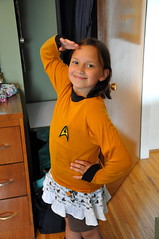
Red shirts were available back then, as well as the blue Mr. Spock style, but I chose Kirk. Of course. - The only sounds I can hear right now: the dishwasher, the fan in the hallway, and the birds in the trees outside the window.
- During my biology degree, Platyhelminthes was a favourite organism name. Now there's a plush toy! (With 2 heads!!)
- When I used to busk with the band, our biggest victories were scaring away the holy rollers across the street (we got applause).
- Neat. When a ship is built, here are the differences between milestones: keel laying, christening, commissioning, etc.
- AutoTune the News #6. Even more awesome.
- Picked up kids from Aldergrove camp. Sadly, there was a terrible accident on the Port Mann Bridge. We took a long Langley/Surrey/New Westminster detour.
- Google's changing culture. Point: Google now has more employees than Microsoft did at launch of Windows 95.
- Time lapse: 8 hours from my front window in about 1 min 30 sec, made with my new Nikon D90 and free Sofortbild capture software (and iMovie):
Something like John Biehler's Nikon Coolpix P6000 is better for timelapse long term; the D90's mechanical shutter, which is rated for 100,000 uses, would wear out in less than 6 months if used for time lapse every day. P.S. Andy Gagliano pointed to a useful Macworld podcast about making time-lapse movies. - Depressing: most Internet Explorer 6 users use it at work, because they're not allowed to use another browser.
- These Christopher Walken impressions are way funnier than I expected.
- The way monkeys peel a banana shows us we've all been doing it the needlessly hard way all these years.
- Um... hot!
- Most appropriate Flash cartoon ever?
- Drinking whisky and Diet Dr. Pepper, watching MythBusters. Pretty mellow.
- A good photo is "not about the details or the subject. It's what your subconscious pulls out of it all without thinking."
- Just picked up another month's supply of horrible, nasty, vile, wonderful, beautiful, lifesaving anti-cancer pills. Thanks, Big Pharma Man.
- My wife tells me she's discovered a sure-fire tip for a gal to attract quality guys in public: carry a huge SLR camera over your shoulder.
- "For the great majority [...] blogging is a social activity, not an aspiration to mass-media stardom."
- Just talked to younger daughter (9) for first time after three days at summer camp. She's a little homesick, but having fun.
- I took a flight over a remote landscape:
- The 50 worst cars of all time (e.g. "The Yugo had the distinct feeling of something assembled at gunpoint").
- I haven't seen either Transformers movie, but that's okay, I saw this.
- Dan Savage: cheating on your spouse should now be known as "hiking the Appalachian Trail." Good point in the article too.
- You can still buy a station wagon with fake wood paneling!
- Train vs. tornado. It does not end well. Watch without fast-forward/scrubbing for maximum tension.
- Just lucked into a parking spot on Granville Island. Time for some lunch.
- Sent the kids off for a week of horse-riding camp today. Wife Air and I had sparkling wine in the garden. Vewwy vewwy quiet around here.
- Just sorted a bunch of CDs. Still several discs missing cases, and cases missing discs. I feel like a total '90s throwback.
- Rules of photography (via Alastair Bird).
- When did the standard Booth Babe uniform become cropped T-shirt and too-short schoolgirl kilt?
- Listening to "Kind of Blue." It's been awhile.
- "A two-year old is kind of like having a blender, but you don't have a top for it." - Jerry Seinfeld (via Ryan).
Labels: audio, biology, blog, cancer, chemotherapy, family, flickr, geekery, google, microsoft, movie, music, oceans, photography, sex, startrek, transportation, video, whistler
05 July 2009
Links of interest 2006-06-28 to 2006-07-04
Once again, while I'm on my blog break, my edited Twitter posts from the past week, newest first:
- Photo of Obama picking up his infamous housefly victim.
- Guess that U2 iPod is never coming back.
- And now: "Ant and Buttercup," my debut HD macro closeup movie from our summer garden:
- My first experiments with off-camera flash during close-up photography:










- If I'm passed at high speed by someone with a Washington plate BOKEH, I now know who it is. He says he'll wave.
- Mammals will play, even between species, even when you'd never expect it—wild polar bear and huskies (slide show via Dave Winer).
- A couple of crows are nesting nearby; they keep landing in our birdbath and on the house and lamp stands, looking ominous. Too smart, crows.
- Sitting in a B.C. garden
No waiting for the sun - CompuServe finally shuts down.
- Just in case you're looking for a $2.1 million convertible.
- Congratulations to Buzz Bishop, Jen, and Zacharie.
- I presume this tiny USB-driven monitor screen is Windows-only, because of drivers? Looks pretty swell. (Via Neal Campbell.)
- Definitive proof I'm not afraid of heights: I love this idea.
- Via John Biehler, I found that as well as MythBuster Adam Savage, his co-workers Grant Imahara and narrator Robert Lee are also on Twitter.
- When I had my first Nikon 25 years ago, I wouldn't have believed I'd ever own one (a D90) with 66 pages of the manual (out of a couple hundred total, in a 16 MB PDF file) just for menu options. Then again, 25 years ago, a friend showed me a shoulder-mounted Betamax camera from Hong Kong, and it was the latest in high tech video too.
- That's the funkiest beat I've ever heard a marching band play (via Jared Spool). Maybe some James Brown next?
- Has anyone pinpointed the exact day that Victoria Beckham stopped being able to smile? Angus Wilson speculates, "whatever day she began to look less like a hot English babe and more like a velociraptor."
- Meg Fowler: "Sarah Palin's quitting politics like Ann Coulter's quitting evil."
- As the 40th anniversary of the first moon landing approaches, some fabulous photos from the missions, via Bad Astronomy.
- From Ben Englert: "Thank you, gdgt, for institutionalizing the arduous task of dick-measuring by figuring out who has more toys."
- Ten best uses of classical music in classic cartoons.
- Our fridge magnet: "I love not camping."
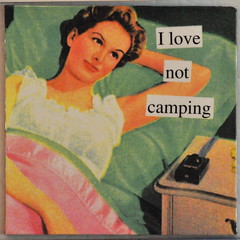
- How did I manage to bite the inside of my upper lip while eating a peach? If this were high school, the guys would say, "Each much?"
- Back to short hair for summer. And now I realize that it's Colbert hair.
- I think my guts have calmed down now. Time for bed. In the meantime, enjoy a naked Air New Zealand flight crew.
- In case you'd like to watch Jeff Goldblum reporting on his own "death," on Colbert Monday: links for Canada and the U.S.A. (sorry if you're elsewhere!).
- Didn't attend various Canada Day parties because of tired family and my usual intestinal side effects. Hope you had fun in my stead. Managed to avoid intestinal chemo side effects for a few days, but they're back with a vengeance. Could be a looooong night. (And it was. At 2 a.m., my chemo side effects were "over" and I went to bed. Bzzt! Wrong! Finally got to sleep at 9 a.m., woke up at 1 the next afternoon. As Alfred E. Neuman says, Yecch.)
- Whatever you think of the 2010 Olympics here in Vancouver, VANOC is doing a good job with graphic design.
- I, too, welcome our new ant overlords.
- I had no alcohol on my birthday yesterday, but still had a Canada Day headache on July 1. Here's my new free instrumental.
- Inside Home Recording #72 is out: Winners, Studio Move, Synth 101, Suckage! AAC enhanced and MP3 audio-only versions.
- Normally I really like our car dealer's service dept, but today the steering wheel came back oh-so-slightly to the left. They had to re-fix it.
- World's geekiest pillows (via Chris Pirillo). My guess: they didn't license the Apple icons. Get the pillows while you can.
- Officially made it to 40. Thanks everybody for the birthday wishes. Most people are bit melancholy to reach 40, but I am extremely glad to have made it.
- Just returned from a Deluxe Chuck Wagon burger (with cheese) at the resurrected Wally's Burgers in Cates Park, North Vancouver:
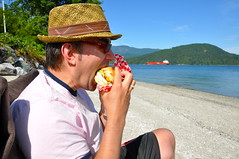
- From Rob Cottingham: "The hell with putting a ring on it. If you liked it, you shoulda made a secure offsite backup."
- Info about recording old vinyl records into a computer: You need a proper grounded phono preamp, with good hot signals into an audio interface or other analog-to-digital converter. A new needle might be wise if yours is old, but the real phono preamp (w/RIAA curve) is the most necessary bit after that. Route it thru an old stereo tuner if needed! See my old post from 2006 at Inside Home Recording.
- Myth confirmed: Baby girl evidence (named Stella) shows MythBusters' Kari Byron actually was pregnant.
- My new Twitter background image is the view we saw at sunset during my birthday party on Saturday. (I've since replaced it again.)
- Back from another fun sunny summer BBQ at Paul Garay's new house—it's been a burgers-n-beer weekend.
- Photos from my 40th birthday party now posted (please use tag "penmachinebirthday" if you post some).
Labels: animals, band, birthday, cartoon, family, food, geekery, insidehomerecording, linksofinterest, moon, movie, music, mythbusters, news, paulgaray, photography, politics, space, transportation, usb
03 June 2009
The rise and fall of General Motors
There's a lot of talk about why General Motors slid into bankruptcy protection this week, but I think you can summarize the situation with two of the company's old cars (photos from the 2009 New York Times GM Timeline):
Top left, the amazing and beautiful 1938 Buick Y-Job concept car prototype (not a beautiful name, but still...), driven by GM design head Harvey J. Earl. That car appeared as the world's first concept vehicle, as GM was ascending to its all-time high U.S. market share, which reached 54% in 1954. It heralded the beginning of artistic design in automobiles, which through the 1920s had looked purely functional and utilitarian.
Bottom right, the 1980 Chevrolet Citation, a front-wheel-drive response to smaller Japanese cars from Toyota, Honda, and Datsun. The Citation was a big red hunk of meh, which drove poorly and lost sales in each of its five years on the market. The 1980s saw GM and other American car makers creating poor imitations of more successful foreign design ideas. GM was by then descending into its current state.
Labels: americas, design, money, transportation
28 May 2009
One weird-ass ship
 At first, you might think a cruise ship collided with an oil rig and then crashed into part of a highway overpass, but no, it's just the M/V Chikyu (via the Maritime Blog). Here's how the BBC describes it:
At first, you might think a cruise ship collided with an oil rig and then crashed into part of a highway overpass, but no, it's just the M/V Chikyu (via the Maritime Blog). Here's how the BBC describes it:
The idea was simple. Scientists wanted to drill down into the Earth's crust—and even through the crust—to get samples from the key zones 6 or 7 km down where earthquakes and lots of other interesting geological processes begin; but that was impossible with existing ships.
Solution: find six hundred million dollars, and design and build a new one.
The Chikyu was built in Japan, is 210 m long (almost 690 feet, as long as a decent-sized cruise ship), and 130 m from the keel to the top of the drilling rig (about 425 feet, taller than a Saturn V rocket floating upright in the ocean). It has a crew of 150.
The crazy structure on the front is a helicopter landing pad. During construction, the ship was nicknamed "Godzilla-maru." And you know, $600 million is a lot of money, but it's not outrageous considering what this vessel does. It's the same price as only two or three 747 jets, for instance.
Labels: geekery, japan, oceans, science, transportation
19 May 2009
Airliners are modern miracles of science and engineering
 We've just returned from a whirlwind trip. My daughters had an extra day off school, a professional day following the Victoria Day long weekend, so we made quick plans to stay in a hotel in the Seattle suburb of Lynnwood, Washington, a couple of hours' drive south of here. But to thread the needle of long weekend border traffic, we crossed our station wagon into the USA on Sunday and returned Tuesday.
We've just returned from a whirlwind trip. My daughters had an extra day off school, a professional day following the Victoria Day long weekend, so we made quick plans to stay in a hotel in the Seattle suburb of Lynnwood, Washington, a couple of hours' drive south of here. But to thread the needle of long weekend border traffic, we crossed our station wagon into the USA on Sunday and returned Tuesday.
I'm not quite sure how we fit all we did into the 54 hours we were away, but it included a number of family firsts. My older daughter is a big fan of shrimp, and has been enticed by endless ads for the Red Lobster chain of restaurants. We have none in Vancouver, so Lynnwood offered the closest location, and despite lingering memories of a 1995 food poisoning incident at a California location on our honeymoon, my wife and I agreed to go. We all enjoyed our meals there Sunday night, without later illness.
That was the least of the newness, though. My wife Air and I have traveled to Greater Seattle many times over the years, separately during our childhoods and together since we started dating, both with our kids and without, for fun and on business, as a destination and on the way elsewhere. Yet somehow neither of us had ever visited the wonderful Woodland Park Zoo, or Lynnwood's famous Olympus Spa, or Boeing's widebody jet factory in Everett. This trip we covered them all: the kids and I hit the zoo, Air visited the spa, and all four of us took the Boeing tour today on the way home.
The zoo impressed me, especially the habitats for the elephants, gorillas, and orangutans, but while it was a much shorter activity, the Boeing tour was something else. If you live in this part of the world (Vancouver, Seattle, Portland, and environs), and you're a geek who likes any sort of complicated technology, or air travel, or simply huge-ass stuff, you must go, especially considering there's nowhere else in the world you can easily see something similar. The Airbus factory in France requires pre-registration months in advance, with all sorts of forms filled out and approvals and so forth. We just drove up to Everett, paid a few bucks each, and half an hour later were on our way in.
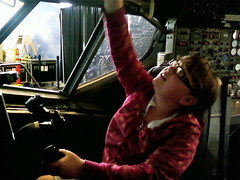 Unfortunately, you're prohibited from taking cameras, electronics, food, or even any sort of bag or purse beyond the Future of Flight exhibit hall where the tour begins, so I have no photos of the assembly plant itself. Trust me, though, it is an extraordinary place. A tour bus drove our group the short distance to the structure, which is the most voluminous building in the world. (Our guide told us all of Disneyland would fit inside, with room for parking. Since the plant is over 3,000 feet long, I figured out that the Burj Dubai tower, the world's tallest building, could also lay down comfortably on the factory's floor space.)
Unfortunately, you're prohibited from taking cameras, electronics, food, or even any sort of bag or purse beyond the Future of Flight exhibit hall where the tour begins, so I have no photos of the assembly plant itself. Trust me, though, it is an extraordinary place. A tour bus drove our group the short distance to the structure, which is the most voluminous building in the world. (Our guide told us all of Disneyland would fit inside, with room for parking. Since the plant is over 3,000 feet long, I figured out that the Burj Dubai tower, the world's tallest building, could also lay down comfortably on the factory's floor space.)
From two separate third-level vantage points inside, accessed by walking down immensely long underground tunnels, then taking freight elevators up into the factory's rafters, we saw more than a dozen of the world's largest aircraft in various stages of assembly. They included several units of the venerable and massive Boeing 747 (its still-revolutionary design is older than me); a couple of nearly complete 767s; a string of 777s in their slow-crawling, constantly-moving U-shaped assembly line; and finally a trio of 787s—a design so new that they are built mostly of composite materials instead of metal, and not even one has yet entered commercial service.
The end of the tour took us outside again on the bus, past the painting hangars and numerous planes waiting for pickup by airlines, as well as one of Boeing's three Dreamlifter cargo monsters, created by cutting off most of the upper half of an old 747 and installing a huge new fuselage top, purely to bring in assembled parts for the new 787s, to be fitted together inside the factory.
While that facility is one structure, which has been expanded over time, each type of plane built there demonstrates how aircraft construction, and industrial assembly lines in general, have changed in the past 40 years. 747s are still built at numerous discrete stations, as they were when the Everett plant first opened in the 1960s. As I mentioned, 777s come together in a single, steady-moving U-shaped line, apparently inspired by the envied Toyota Production System, each plane edging forward steadily at 1.6 inches per hour.
Finally, the new 787 comes together in a short, simple line across the width of the building. That's because (as with competitor Airbus's planes) sections of each aircraft arrive nearly complete from other factories around the world on the Dreamlifter cargo carriers, and are put together in Everett, rather than built from scratch.
I came away newly inspired by the modern miracle of science and engineering that is a jet airliner. These machines are what enable us to complain about waiting around in airports for a few hours, and about substandard in-flight food as we fly between continents—while forgetting that not many lifetimes ago, and for all of human history beforehand, similar voyages might take have taken us years instead of hours, facing danger and starvation and death, if they were possible at all.
Then, on the way home, we bought a bunch of squeeze cheese, also unavailable here in Canada.
Labels: airport, americas, animals, family, geekery, science, seattle, transportation, travel
26 April 2009
Taking photos doesn't make you a terrorist
As far as I know, no actual or suspected terrorist has ever scoped out a potential target by walking around or in it in plain view, with a big camera and lens, and taking pictures. The 9/11 hijackers didn't, the U.S.S. Cole attackers didn't, the bombers of the London Underground and Madrid and Bali didn't. The FLQ kidnappers in 1970 didn't. Ahmed Rassam didn't. Suicide bombers in Israel and Iraq and Afghanistan don't.
So ads like this one, postered at SkyTrain stations here in Vancouver as the 2010 Olympics approach, bother me:
The theme of the ad campaign is "report the suspicious, not the strange." It's an odd slogan. What's the difference between, "Hey, that's strange" and "Hey, that's suspicious"?
And the examples it gives are ridiculous. In this particular instance, if you see a camera floating in mid-air with a translucent, ghost-like figure beneath it, you should apparently call a paranormal investigator. But if you see a man with a DSLR taking photos of the security camera in the station, report that to the Transit Police, because he could be a bad guy.
Here's the thing. Taking photographs in public places isn't illegal in Canada. (Is a SkyTrain station a public place? Interesting question.) Neither is it illegal in the U.S., nor in Britain—though laws are more restrictive in the U.K.
A U.S.-based lawyer has put together a quick PDF card about photographers' rights, and it's also interesting to note that TransLink itself has responded to photographers' concerns about the campaign:
Specifically, the image of the photographer is not intended to say photography and photographers are bad. It's intended to say that a person who is intently making records of specific transit security elements like cameras should raise a flag as suspicious activity.
...but:
They're taking pictures of wiring, pipes, electrical panels. Well, I'm sorry, not many people go around doing that.
Really? Sure about that? Hmm?
The problem, of course, is that while TransLink staff and police may understand that intention (I hope!), the implication is that if members of the general public see a photographer taking pictures of something other than friends and family, they should be suspicious and report it. In short, that they should be afraid.
There's a more general message in these types of campaigns, and the way some reporters and photography enthusiasts are treated by authorities, too: that big cameras with big lenses are particularly evil, as this satire notes:
I don’t want to be too technical, but the focal length of the lens is directly correlated with hatred of America. It goes something like this:
You have a a cell phone camera, point and shoot, or 20mm wide angle lens: you are a red blooded American who wants to celebrate our national heritage by taking pictures of popular tourist locations.
A 50mm lens: you are also, by and large, a good American, but you have a disturbing interest in “understanding” the terrorists and why they attack us.
An 85mm lens: you loathe your own country and secretly admire the 9/11 hijackers for giving us our comeuppance. You are not a terrorist, but your camera should probably be confiscated and your pictures deleted, lest they find their way to al Jazeera message boards. Your middle name may be Hussein.
A 200mm lens: you are an al Qaeda henchman actively scouting for security vulnerabilities.
A 300mm lens: you ARE bin Laden!
This approach, of course, is the very opposite of sensible. If terrorists really were checking out a target, they would probably work to be as surreptitious as possible. Use small cameras, like the camera phone I used to photograph the ad poster. Memorize things and sketch them out later. Steal plans. Not plop down a big-ass tripod out in the open and carefully compose an image with a huge DSLR and a monster chunk of lens mounted it. At the very least, all that gear would make it hard to get away quickly and unobtrusively.
You know what I think has really prompted this security theatre? Spy movies and TV shows. That's where you see the telephoto lenses in the hands of the bad guys, and the good guys, for that matter. (Then again, James Bond prefers small cameras.)
What this approach fails to notice is that those are fiction.
Labels: controversy, olympics, photography, terrorism, transportation
15 February 2009
How to make a pleasant airport
Salon's Patrick Smith, pilot and aviation writer, has a great list of 15 things all airports should have, created in consultation with his readers:
- A fast, efficient, low-cost public transportation link to downtown
- Complimentary wireless Internet
- Power ports
- Convenience stores ("What's with all the luggage stores? Who the hell buys luggage after they get to the airport?")
- Showers and a short-stay hotel
- Play area for children
- ATMs
- An information kiosk
- A place to send mail and buy postage
- A bookstore
- Ample gate-side seating: at least as many chairs as there are seats on the plane!
- A quiet area
- Art and greenery
- Double-wide escalators
- Windows with a view of the planes
Vancouver's airport is pretty good (the transit is coming this year, there's a good play area, and you can see the planes in several places), but in general we do a crappy job of these in North America.
If you're killing time at YVR, I strongly recommend a (slightly pricey) meal or drink in the lounge of the attached Fairmont Hotel. It's quiet, comfortable, the food is good, and you can both watch the aircraft and enjoy a nice view of our mountains. We try to go there anytime we're flying, or even dropping off or picking up family and friends.
Labels: airport, americas, transportation, vancouver
02 February 2009
Ten worst best cars
Via Ken Rockwell, here's the kind of list you don't see very often: Car and Driver admitting to a list of 10 Most Embarrassing Award Winners in Automotive History, including many of their own choices. The Renault Alliance and Chevy's Vega and Citation were all award-winners at one point. That is embarrassing.
One of the reason car aficionados love BBC's Top Gear is that they rarely make such mistakes. They even have a category of "WTF? Car" for particularly egregious examples of bad or misguided motor vehicle design. Scroll down the Foreman Blog home page for a fun list of them.
Labels: blog, humour, magazines, transportation
09 January 2009
This is not a model train
I know this photo looks like a model train, but it's not:
It looks like a model because of a fake tilt-shift lens effect. Oddly, the idea came up twice in one day: Stephen wondered if I knew about tilt-shift photography, and the same day TiltShiftMaker showed up on the Web (thanks to Scott for the link to that). Since I don't own any tilt-shift (a.k.a. perspective control) lenses or a Lensbaby, a free online tool was the perfect way to fake it.
The picture is from Interstate 5 near Tacoma, Washington, in summer 2005. It is actually a real train on a real railway with real trees and the real Mt. Rainier in the background. It looks like a model because of the selective focus effect I applied to the original image with TiltShiftMaker—one reason we know models are tiny is that the depth of focus when we look at them is much shallower than for larger objects. Simulating that effect makes big things look small.
Look, I tried it on a bunch of other pictures too.
Labels: geekery, photography, transportation, travel, web
27 October 2008
The doom of the American car company
Via Brian Chin, the Wall Street Journal's "How Detroit Drove Into a Ditch" is a succinct history of why General Motors, Ford, and Chrysler are fumbling towards bankruptcy while the 16 U.S.-based vehicle factories run by foreign firms like Toyota, Nissan, Honda, Hyundai, Mercedes-Benz, and Volkswagen are profitable and prosperous:
...to thrive, instead of just survive, Detroit will have to use the brains of its workers instead of just their bodies, and the [United Auto Workers] will have to allow it. Two weeks ago some automation equipment broke down at the Honda factory in Marysville, Ohio, but employees rushed to the scene and devised a temporary solution. There were no negotiations with shop stewards, no parsing of job descriptions. Instead of losing an entire shift of production, Honda lost just 150 cars.
I don't think many people of my generation favour American brands when considering a new car. For me, GMs, Fords, and Chryslers are far from the top of the list: generally, when I sit in a new car built by one of those companies, something about it often feels cheap, which isn't the case with their Asian or European competitors' vehicles. Our Ford Focus has been a decent station wagon over the past seven years, but our Toyota Echo, which was much cheaper, has needed far fewer repairs.
Seeing one or more of the Detroit Three collapse would be sad, but personally I'd have no reason to miss them.
Labels: americas, money, transportation
